
Is it Time to Sell? Overview of Personal & Business Readiness
March 14, 2019
19 Tips for Improving Accounts Receivable Collections
March 18, 2019How Much Cash Should You Stash in Your Business and Personal Accounts?

In my most recent Value Growth article, I mentioned that a CFO, or the person who leads your finance department, should oversee four divisions of your business – treasury, tax, accounting, and finance. Subsequently, those in the treasury division of your business handle cash flow, investments, accounts receivable (income), and accounts payable (expenses). Since cash flow is the bread and butter of your business, I want to discuss that. Specifically, I want to talk about how much cash you should stash in your business and personal accounts.
Podcast Time Index for “How Much Cash Should My Business Hold?”
00:28 – How Much Cash Should My Business Hold?
01:28 – The Four Account Method
03:26 – Personal Accounts
05:53 – Business Accounts
08:53 – Cyclical Businesses
10:35 – Focus on the CFO
11:02 – Money in the Bank
12:09 – Summary
The Four Account Method
Most of the time, I find that business owners forsake their personal finances to build their businesses. As a matter of fact, they are operating their businesses to the detriment of their personal finances. Therefore, I often suggest that my business owner clients use a Four Account System to stabilize their financial situation and to sustain their personal and business lives. In other words, they need to have two accounts for their personal cash flow and two accounts for their business cash flow.
Here’s how the Four Account Method works:
1 – Personal Checking Account
First, I recommend keeping the amount of money you and your family use on a monthly basis as a cushion in your personal checking account. For instance, if you and your family earn and spend approximately $5,000 each month, then you need to keep an ongoing balance of $5,000 in your checking account.
2 – Personal Savings Account
Next, I generally recommend keeping five to seven months’ worth of monthly cash flow in your personal savings account if you are a one-income family. If you are a two-income family, then you may only need four to six months’ worth of cash in your “emergency fund.” Thus, if you make and use $5,000 each month, keep $20,000 – $35,000 in your personal savings account. So, how much money should you keep in your business account?
3 – Business Checking Account
Now that you have your personal checking and savings in check, you want to work on having the right amount of money in your business accounts. If your business income remains steady throughout the year, then I typically recommend keeping your budget baseline in your business checking account. Like you did in your personal accounts, determine how much cash comes in and out of your business each month and keep at least that amount in your business checking account. Thus, if you earn and spend approximately $100,000 each month, keep $100,000 in funds in your checking account.
However, if you work in a business whose income ebbs and flows according to seasons, I generally recommend keeping three times the amount of monthly cash flow in your checking account. In other words, if your expenses amount to $100,000 each month, keep a baseline of $300,000 in your business checking accounts to get you through the slow seasons.
4 – Business Savings Account
Finally, I recommend that you keep two months’ worth of business expense necessities set back in a business savings account. These non-volatile expenses could include basic utilities, rent, debt payments, employee payroll and liabilities, insurance premiums, and so forth. Traditionally, if you have two months’ worth of necessary expenses set aside and you have a stable income, then you can weather the worst storms that come.
An Exception to the Rule
I have yet to hear business owners tell me they have too much cash in the bank. However, there is one exception to the Four Account Method. If you are looking to sell your business in the next five years, then cash could be an enemy to you. At this point, you want to remove excess cash from your accounts because buyers could think you need that much cash to sustain your business. That could negatively affect your business’s valuation.
RELATED READING: How Much of a Cash Reserve Does My Business Need
Why You Should Stash Your Cash
The psychology behind this “cash stash” is amazing. I’ve worked with many business owners who struggled to reserve this much cash. Yet, once they had “enough” in their personal and business accounts, their businesses began flourishing. But why? Why does this work?
The Four Account Method works because it reduces business owners’ stress. With a security blanket in the bank, you have the ability to go out and take risks you weren’t able to take before. This could be one way to answer the question, “Should I leave money in my business account?” But as business growth experts, we know the optimal amount for your business depends on your particular situation. Reach out to us. We have worked with so many businesses, we can help you determine real, business-growing numbers.




